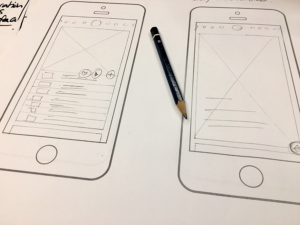REAL-WORLD THINKING ON BUILDING MOBILE APPS THAT SCALE
Most mobile apps are built to ship, not to last. They’re rushed through development, patched post-launch, and quietly fail under real-world pressure. We’ve seen it happen too often, bloated codebases, shortcuts on scalability, poor architectural decisions that come back to bite. That’s why, at Ronins, we treat mobile app development as infrastructure, not just interface.
This hub is where we get into the bones of modern mobile development. How to architect for scale without overengineering. How to pick the right framework for your roadmap, not just your MVP. How to build for performance, maintainability, and the next version, not just the first. Whether you’re fixing a fragile build or starting from zero, these are the truths that keep apps running and businesses growing.
Apps That Perform, Scale and Actually Deliver
Tech Stack Decisions, Dev Tactics, and Architecture Choices That Actually Scale
Mobile app development isn’t just code, it’s architecture, performance, and commercial survival. In this section, we share what really matters when building apps that have to scale, adapt, and prove ROI. From native vs cross-platform decisions to performance tuning, backend choices, and feature rollout strategies—this is the thinking that keeps apps running and users coming back.

OUR MOBILE APP INSIGHTS
Who We Write For
Founders & product owners: You’re not just launching an app, you’re building a business on top of it. These insights help you navigate build-vs-scale decisions with clarity and confidence.
CTOs & technical leads: Whether you’re choosing between Flutter and native, rearchitecting for performance, or dealing with a tangled legacy codebase, this is the strategic lens you’ll want.
Marketers & growth teams: You need the product to perform, not just function. We cover post-launch thinking: retention, updates, analytics, and feature iteration that drives ROI.
Digital & innovation teams: Whether you’re inside a brand or scaling a startup, we help you pressure test ideas and turn MVPs into real, resilient platforms.
Cross-functional collaborators: From UI designers to QA testers, we write for the people who keep the app experience consistent and the releases rolling smoothly.

OUR CONTENT FOCUS
What We Write About
App architecture strategy: Monolith vs microservice? Native vs hybrid? We cover the tech stack decisions that affect cost, performance and long-term flexibility.
Building for scale: From version control to feature flags and edge-case testing, we write about the development patterns that keep apps stable as they grow.
Speed, performance & UX: We dive into what makes apps fast, battery-efficient and intuitive—especially under pressure. Expect no-nonsense advice on optimisation that matters.
Code quality & handover readiness: You’ll find tips on writing modular, maintainable code—and building dev pipelines that don’t crumble during handover or growth sprints.
Real-world use cases: Every insight is drawn from the apps we’ve built and scaled—from commerce and healthcare to smart devices and live-data feeds.

FAQs
Answers to the real questions clients ask before they hire us
What’s the best tech stack for mobile apps?
There’s no one size fits all answer. Your stack should align with your product roadmap, team skills, and performance goals. We help founders weigh native (Swift, Kotlin) vs. cross-platform (Flutter, React Native) based on long-term cost, scale, and user expectations. For some apps, hybrid works. For others, it’s a liability. Choosing wisely up front avoids painful rewrites down the line and ensures you’re not locked into a platform that limits future growth or feature innovation.
Can I build once for iOS and Android?
Yes, with trade-offs. Frameworks like Flutter and React Native offer faster, cross-platform development. But not all features behave equally across devices. Performance, UX, and integrations can vary. We help clients assess where a shared codebase works—and where native is worth it. If rapid MVP launch is your goal, cross-platform helps. But if long-term stability or deep OS integration matters, native may be safer. We guide clients based on business needs, not hype.
What makes an app feel fast and fluid?
Speed isn’t just server load, it’s perception. We design for quick interactions, smart preloading, reduced wait states, and lean UI code. Caching strategies, gesture handling, and responsive animations all shape the user’s sense of “snappiness.” Many teams optimise backend logic but forget the frontend feel. We address both. Testing on real devices—not just emulators, also reveals micro-lags and missed frames that drag the experience. We treat performance as a design factor, not just a technical one.
How do you test apps before launch day?
We embed QA from sprint one. Our test approach covers unit testing, integration testing, device testing and UI smoke tests across form factors. We simulate bad connections, legacy devices, offline mode, and edge-case flows, because that’s what your users will experience. App store approval is only the baseline. We aim for robustness, not just passability. QA isn’t a handoff stage at Ronins, it’s part of every sprint, with automation where it matters and real humans where it counts.
What if the app breaks after it’s launched?
We build apps to handle failure gracefully, error states, fallbacks, and monitoring are built-in. But if something breaks post launch, our support structure kicks in. We offer staged rollouts, performance monitoring, crash reporting, and emergency response plans. Our team actively patches, not just reacts. From analytics to backend logs, we isolate and resolve issues quickly. And if it’s a 3rd-party integration at fault, we coordinate fixes. The goal: visibility, speed, and trust when things go wrong.
Can you work with my internal dev team?
Yes, often we do. Some clients bring us in for architecture guidance, frontend support, QA reinforcement, or dev capacity bursts. We’re used to pairing with in-house teams, whether they need mentoring, audits, or pure delivery. We adapt to your stack and rituals, and avoid creating silos or tech debt. If your team’s stretched, we support. If you want to upskill, we collaborate. The handoff is clean. The code is yours. The mindset is partnership.
Do you help with app store submissions too?
Absolutely. We’ve submitted dozens of apps to both iOS and Android stores, including complex multi-market and regulated launches. We handle metadata, screenshots, review compliance, and phased rollouts. We know what flags Apple and Google look for, especially around privacy, health, and subscriptions. For new clients, we also offer app store optimisation (ASO) to improve visibility. If you’ve been rejected before, we troubleshoot the reason. Our goal: smooth approval and strong discoverability from day one.
What if I already have an app that’s failing?
We plan for this from the start. Every app includes version control, changelogs, rollback paths and staged release plans. Updates don’t just add features, they address compatibility, security, and user feedback. We recommend regular cadence updates alongside hotfix capacity. Feature flags and CI/CD pipelines help you ship safely without breaking production. We also advise on user communication—so changes don’t feel abrupt. Our process helps you stay responsive without risking platform stability or customer trust.
How do you handle versioning and updates?
We plan for this from the start. Every app includes version control, changelogs, rollback paths and staged release plans. Updates don’t just add features, they address compatibility, security, and user feedback. We recommend regular cadence updates alongside hotfix capacity. Feature flags and CI/CD pipelines help you ship safely without breaking production. We also advise on user communication, so changes don’t feel abrupt. Our process helps you stay responsive without risking platform stability or customer trust.
Do you offer post-launch feature support?
Yes. We offer retained support for clients who want ongoing improvements, not just maintenance. That includes adding features, improving onboarding, evolving UX, or scaling infrastructure. Some clients use us to test feature variants. Others want help shipping faster while in-house teams focus on core systems. We don’t just fix bugs, we move product forward. Whether it’s monthly sprints or on-demand briefs, we work in rhythms that suit your roadmap and budget. Your app isn’t static. Neither are we.





